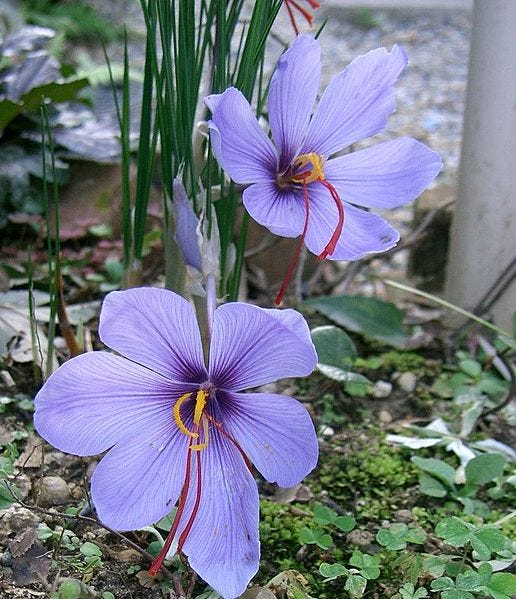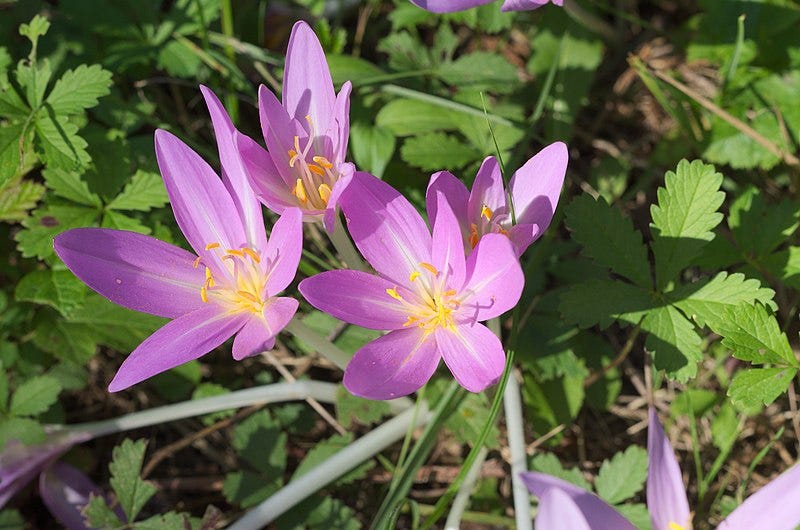ALSO KNOWN AS: Crocus sativus, Za'afarn (Persian), saffron crocus, autumn crocus
How to know
Pale purple coming up as delicate as goose eggs with golden centers
Long narrow leaves like grass
Colonies come up like carpets of purple
Red styles among the gold anthers
No stems, just petals emerging from the ground. This plant has been called naked.

Western culture began with violence. And not only war - violence in the form of natural disaster. The small islands that held the Minoan peoples of the ancient world which expanded through the decades into the place western culture now calls its roots in Greece, were bare flecks in the sea under which the plates of Africa and Eurasia meet, and move. Gods were not kind. Monsters were terribly real and manifested in the eruptions, quakes, and tsunamis that struck with consistency.
But from this earth, not only sprung rivers of lava, fire, and water but a calm thing, as delicate as an egg. The crocus, one of the last things to grow in the Mediterranean before winter, came up like a pause in the storm, a gift from the gods. But, of course, value creates its own kind of tempest.
The Durability of the Flower Egg
Summer ends in purple and yellow with the asters, goldenrod, sunflowers, and monkshood, those fleshy flowers that have taken a season to develop. But spring also starts in yellow and purple, purple for the crocus and yellow for the daffodil and witch hazel.
The saffron crocus bookends the season - it is the second crocus of the year, mirroring that very first bloom of the Crocus vernus in spring. They look very similar to one another and they are very closely related. But the saffron crocus has a powerful legacy as the valuable spice we know so well.
When everything else has died back for the season, saffron crocus blooms over the bare soil forming a thin purple cloud.
Crocuses don’t have stems per se. Their flowers are pale at the base and open out into six petals. In this way they look a bit alien. The common green stem is gone and they seem to float. You can tell a saffron crocus from other species of crocus by the shocks of three red stigmas emerging from its throat. Some plants show us how valuable they are in the way we must interact with them. Saffron is one of those plants that can’t be scaled without an extravagant price point. Sure, if you yourself had saffron, it would cost little to keep and manage in small quantities. But they don’t like to be sold. And they were bred that way.
The flowers are sterile. They don’t call any pollinators to them. No insects visit their red ribboned stigmas, or female parts, nor is their pollen transported. They are bare in more ways than this. They have very little genetic diversity so saffron will never be able to divert from being saffron. The saffron crocus itself is a result of a mutation. Its corms were cut countless times over to clone it. This is the only way it reproduces. It’s known as a sterile triploid, meaning it has three chromosomes. If we didn’t cultivate it, it wouldn’t exist. Studies have shown that Crocus cartwrightianus is the wild descendant, though the process of cultivating saffron into what we know it as today is not entirely understood.
The truth is that no one is certain where it is endemic. Its closest relative can be found on the Cyclades, but arguments for its endemism have stated the flowers are native to Northern India or Iran. Either way it has been cherished and traded, and carefully cultivated for at least 3,500 years with a longstanding tradition of cultivation in India, Greece, and Iran. Wherever their source they come from rocky soil, arid long summers and cool, dry winters. And despite their native Mediterranean habitat, they’ve also grown on sopping English plains. As plants go - they’re actually quite durable.
It grows about 6” from a small corm similar in structure to an onion - the pale underground stem - that’s usually no bigger than a frog. This classic corm gives away its iris lineage. The little subterranean heart supports no more than four flowers. The leaves come up in lance form. So one glance might make the crocus appear to be a single flower peaking from a tuft of grass.
And yet this crocus the one cultivated on Grecian islands for the sake of art, beauty, and importantly, health, is presumably the namesake of all of crocuses. Krokus is the Greek word for saffron, even though there are around 85 species of crocus around the world.
In the mainland of Greece where western civilization had its prophetic stirrings, did the seers in Delphi see flowers and know how much they would travel, how much they would be worth? They did. Saffron had already spread the through the known world like a small, golden fire, floating down the mountains, transported through the world from their native soil that is full of mineral: granite, schist, shale or limestone. Spreading through the world from their arid climates where muscly evergreens bear against incoming winds.
A Plant That Makes Gods
The saffron crocus is by far the most valuable spice on the market. Vanilla, the second most valuable, is ten times less in price. It takes 75,000 flowers to make one pound of saffron. They have both male and female parts - though sterile - and their bloom time is a few weeks in October and November. The flowers themselves only bloom for about one week at a time. The stigmas are then harvested from the plant with tweezers. These are bright red against the purple backdrop of the flower, and there are only three of them per flower. The flowers are too small and too delicate to be handled by a machine, so the work of harvesting and separating the stigmas from the flower is done by hand. Not only this, but harvesters must rise early in the morning, before the crocus has opened in the sun, to get the best result. Once the saffron is processed the corms are cut in half and replanted to reproduce. Currently, 90 percent of saffron is produced in Iran and it takes up a massive amount of space because each acre produces only 1.8 kg of saffron. In the medieval ages there used to be a robust saffron industry in England, and recently, farmers in the northeast US have found that saffron can be a cash crop.
We cultivated nearly nothing for outside ecological importance other than their beautiful red stigmas and their profound healing, woven through their tiny bodies. It’s been used as a treatment for rheumatism and measles. More than 150 volatile and aroma yielding compounds. This aroma is entirely enchanting, literally, enough of it can produce narcotic effects. But small whiffs are known to inspire the senses. Because of this it is used by many indigenous and traditional medicines throughout the Mediterranean region. The farming of saffron has become more difficult as climate is changing in the regions. Even though the plant itself is durable in cold climates, the saffron taste is dependent upon rainfall - a rain just before the bloom.
The color is without equal. It’s been used to paint and dye hair, and give skin a sheen of gold and in textiles in a pigment called za’fran, which means “yellow flower” in Persian. Cleopatra bathed in it and Alexander the Great dyed his hair with it. These powerful people used it to enhance their brilliance. Henry VIII had his tights dyed with saffron to make a brilliant golden red. As a colorant for food saffron is a main ingredient in bouillabaisse, paella, and risotto.
The allure of saffron is undeniable. Entire rooms of frescos dedicated to the plant make up the labyrinthine castle walls of the Mycenaean people. Along these ancient walls painted in the middle Minoan period, depict saffron harvesters, and the goddess whose blood made the bright red stigmas that are so prized.
Saffron, probably most significantly is a potent medicine that has antihypertensive, anticonvulsant, antitussive, antigenotoxic, cytotoxic, anxiolytic aphrodisiac, antioxidant, antidepressant, antinociceptive , anti-inflammatory, and relaxant effects - yes all of this. These are due mostly to the specific carotenoids it contains. It has been known to treat about 90 separate illnesses. Prized wherever they touch ground, the saffron was believed to be a remedy for the plague. It also helps with blood flow in the eyes and aids in memory retention. And it’s narcotic. Come too close to too many saffron stigmas and receive a powerful high. Nuns in Germany were known to cherish the saffron, because the narcotic effects helped them sing longer, with more vitality for the hours upon hours that they sang for the salvation of humanity. Saffron has also been proven as an antidepressant that equals some antidepressants on the market, without the common side effects.
I think about the meaning of value. Humans are interested in creating hierarchies. Things are valuable in as much as we owe them. True value is a form of justice that sets a standard for balance of labor and output. Money is merely a representation of the debt we must pay for work. When we are planting the saffron we are paying the debt we made to create them.
In many ways gods themselves are cultivated by humans. Over millennia we have made sacrifices to them and prayed to them. They are no more real than our imaginations, that place where story comes from, a place of deep influence. Saffron is an inspiration to us. And, like gods asking for gifts, saffron too - it needs our attention.
The plant is inherently valuable. It would have gone on just fine as a Crocus cartwrightianus. But someone, on a hill in the Mediterranean air, saw it, smelled its bittersweet aroma with after notes of honey, saw how gold came from its throat. How could we not resist the allure? Had we not cultivated this specific mutation it would have been a blip, but we kept saffron as our own. Like a story passed down. These flowers were a bed for Zeus. It is, like Zeus, the maker of magic, elevating mortals in the eyes of their peers.
Myth for saffron crocus
Text for myth, song reference: https://www.loc.gov/item/flwpa000311/
Not to be confused with autumn crocus. This is not a crocus at all, though it grows from a bulb and is purple.

Or dwarf iris. These are small, yet the have the iris modified petals with the yellow shock at the base. They are generally much darker than the saffron crocus, and will bloom in the spring.
Forager Friendly?
No, this is a cultivated plant and doesn’t grow on its own.
Sources
https://pmc.ncbi.nlm.nih.gov/articles/PMC3249922/
https://www.missouribotanicalgarden.org/PlantFinder/PlantFinderDetails.aspx?taxonid=281106
https://en.wikipedia.org/wiki/Saffron
https://pubmed.ncbi.nlm.nih.gov/30946897/
https://gastropod.com/meet-saffron-the-worlds-most-expensive-spice/
https://www.greekchemistinthekitchen.com/post/saffron
https://www.sciencedirect.com/topics/agricultural-and-biological-sciences/crocus-sativus
https://www.youtube.com/watch?v=fP2WUnBjmkk
https://pfaf.org/user/Plant.aspx?LatinName=Crocus+sativus
https://crocussativus.eu/en/history-of-saffron/
https://www.eattheweeds.com/tag/crocus-cartwrightianus/
https://uk.inaturalist.org/taxa/346198-Crocus-cartwrightianus
https://powo.science.kew.org/taxon/urn:lsid:ipni.org:names:436500-1
https://www.sciencedirect.com/science/article/abs/pii/S0924224416302187
David Graber, Debt: The First 5,000 Years
https://www.illaherareplants.com/blog/m3olkg1106p2giznxzamoyy2fh4j54




